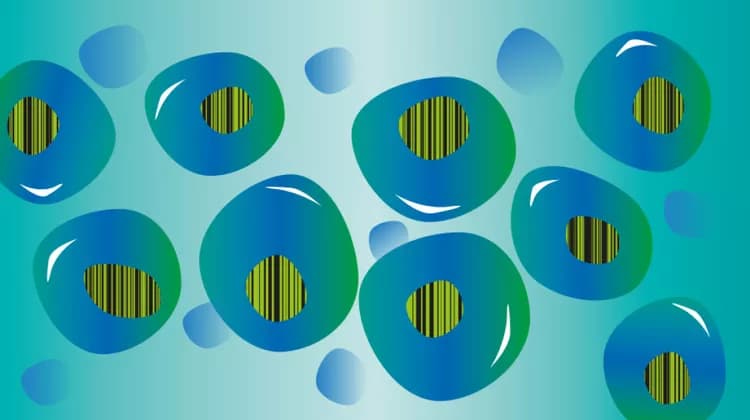
Using Barcodes To Trace Cell Development
How do the multiple different cell types in the blood develop? Scientists have been pursuing this question for a long time. According to the classical model, different developmental lines branch out like in a tree. The tree trunk is composed of stem cells and the branches are made up of various types of progenitor cells that can give rise to a number of distinct cell types. Then it further branches off into the specialized blood cells, i.e., red blood cells, blood platelets and various types of white blood cells that are part of the immune system. In recent years, however, doubts about this model have arisen.
Hans-Reimer Rodewald, a scientist at the German Cancer Research Center (Deutsches Krebsforschungszentrum, DKFZ) in Heidelberg, and his co-workers wanted to capture the dynamic events in blood cell formation instead of merely taking snapshots. In close collaboration with a research team led by systems biologist Thomas Höfer, the scientists have developed a new technology that enables them to precisely follow the developmental tracks of cells. To this end, they label stem cells with a kind of genetic barcode in order to be able to clearly identify their offspring later.
"Genetic barcodes have been developed and applied before, but they were based on methods that can also change cellular properties," Rodewald said. "Our barcodes are different: They can be induced tissue-specifically and directly in the genome of mice -- without influencing the animals' physiological development." The basis of the new technology is the so-called Cre/loxP system that is used to rearrange or remove specially labeled DNA segments.
Weike Pei und Thorsten Feyerabend in Rodewald's team bred mice whose genomes exhibit the basic elements of the barcode. At a selected site, where no genes are encoded, it contains nine small DNA fragments from a plant called Arabidopsis thaliana. These elements are flanked by ten genetic cutting sites called IoxP sites. By administering a pharmacological agent, the matching molecular scissors called "Cre" can be activated in the animals' hematopoietic stem cells. Then code elements are randomly rearranged or cut out. "This genetic random DNA barcode generator can generate up to 1.8 million genetic barcodes and we can identify the codes that arise only once in an experiment," Höfer said.
"The mice then do the rest of the work," said Rodewald. When these specially labeled hematopoietic stem cells divide and mature, the barcodes are preserved. In collaboration with the Max Delbrück Center for Molecular Medicine, the researchers have performed comprehensive barcode analyses in order to trace an individual blood cell back to the stem cell from which it originates.
These analyses have revealed that two large developmental branches start out from the hematopoietic stem cells of the mice: In one branch, T cells and B cells of the immune system develop; in the other, red blood cells as well as various other types of white blood cells such as granulocytes and monocytes form. All these cell types can arise from a single stem cell. "Our findings show that the classical model of a hierarchical developmental tree that starts from multipotent stem cells holds true for hematopoiesis," Rodewald emphasized.
The system developed by the Heidelberg researchers can also be used for other purposes besides studying blood cell development. This strategy can basically be applied in any tissue. In the future, it might also be used for experimentally tracing the origin of leukemias and other cancers.
Materials provided by German Cancer Research Center (Deutsches Krebsforschungszentrum, DKFZ). Note: Content may be edited for style and length.
Disclaimer: DoveMed is not responsible for the accuracy of the adapted version of news releases posted to DoveMed by contributing universities and institutions.
Primary Resource:
Weike Pei, Thorsten B. Feyerabend, Jens Rössler, Xi Wang, Daniel Postrach, Katrin Busch, Immanuel Rode, Kay Klapproth, Nikolaus Dietlein, Claudia Quedenau, Wei Chen, Sascha Sauer, Stephan Wolf, Thomas Höfer, Hans-Reimer Rodewald. (2017). Polylox barcoding reveals haematopoietic stem cell fates realized in vivo. Nature. DOI: 10.1038/nature23653
Related Articles
Test Your Knowledge
Asked by users
Related Centers
Related Specialties
Related Physicians
Related Procedures
Related Resources
Join DoveHubs
and connect with fellow professionals

0 Comments
Please log in to post a comment.